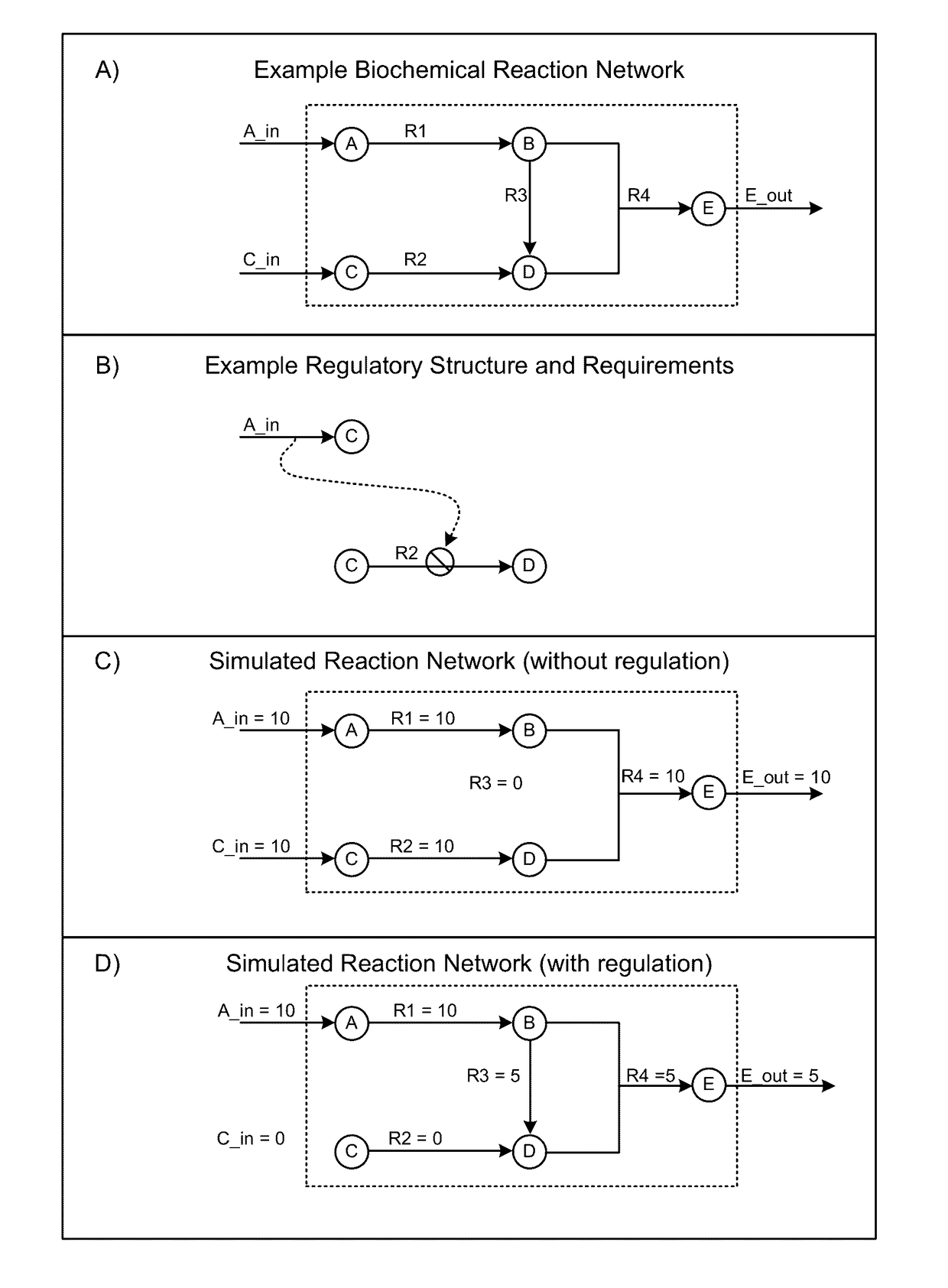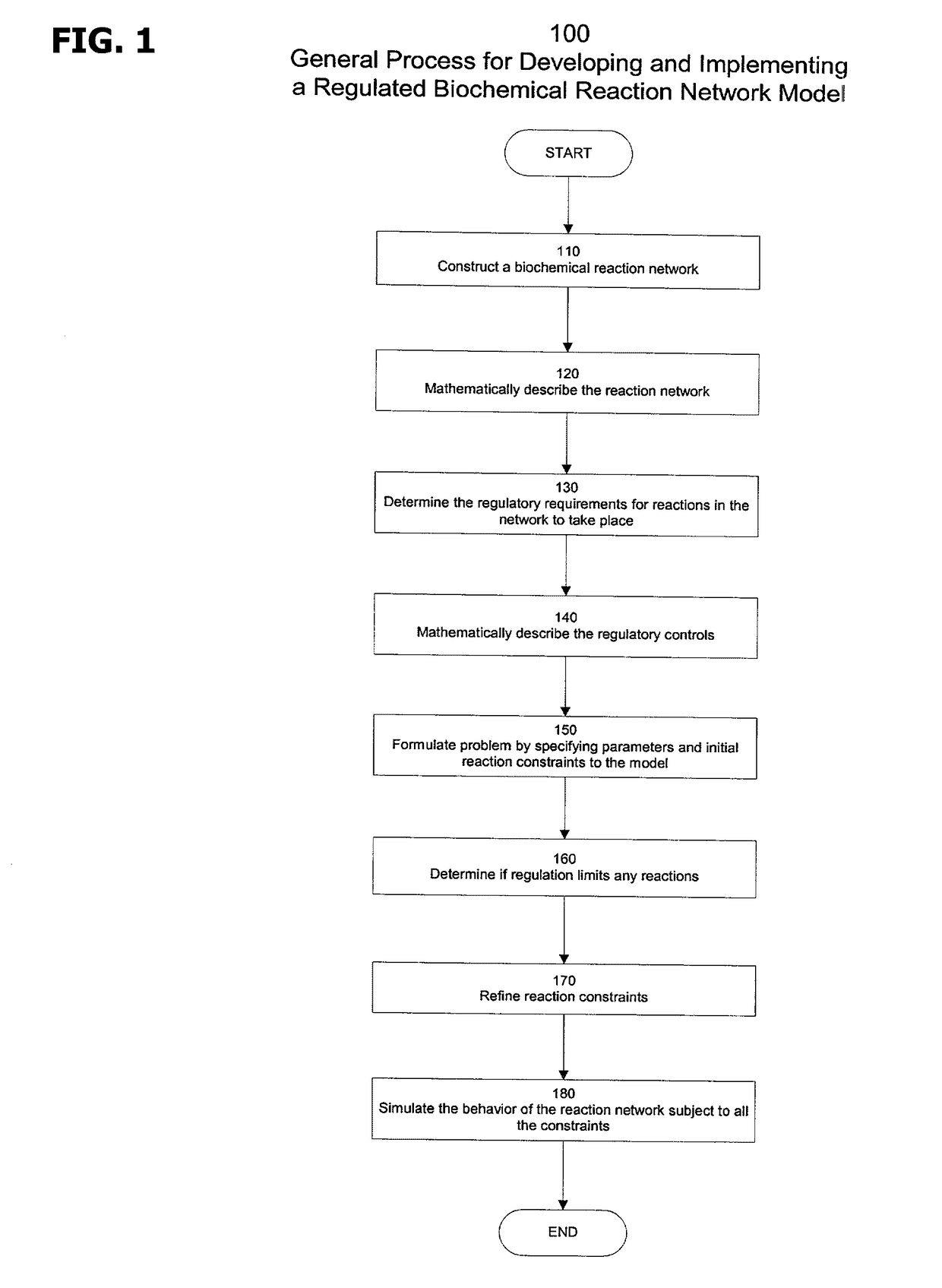Models and methods for determining systemic properties of regulated reaction networks
a technology of regulated reaction networks and systemic properties, applied in the field of computational approaches for the analysis of biological systems, can solve the problems of inability to a priori predict the effect of a single gene or gene product change, the effect of a drug or an environmental factor, on cellular behavior, and constraints-based models that attempt to describe cellular behavior do not take into account these complex regulatory controls
- Summary
- Abstract
- Description
- Claims
- Application Information
AI Technical Summary
Benefits of technology
Problems solved by technology
Method used
Image
Examples
example i
Pathway Reduction in an Exemplary Metabolic Model
[0138]This example describes construction of a skeleton metabolic model having regulatory constraints. This example demonstrates that the inclusion of regulatory constraints in a flux balance analysis simulation increases the predictive ability of a skeleton metabolic model by reducing the size and dimensionality of the mathematical solution space produced by the model.
[0139]A skeleton of the biochemical reaction network of core metabolism was formulated, including 20 reactions, 7 of which are regulated as shown in the upper panel of FIG. 7. This network provided a simplified representation of core metabolic processes including glycolysis, the pentose phosphate pathway, TCA cycle, fermentation pathways, amino acid biosynthesis and cell growth, along with corresponding regulation pathways including catabolite repression, aerobic / anaerobic regulation, amino acid biosynthesis regulation and carbon storage regulation. The skeleton biochem...
example ii
E. coli Metabolic and Regulatory Genotype and in Silico Model
[0142]This example demonstrates construction of a genome-scale combined regulatory / metabolic model for Escherichia coli K-12.
[0143]The annotated sequence of the Escherichia coli K-12 genome was obtained from Genbank, a site maintained by the NCBI (ncbi.nlm.gov). The annotated sequence included the nucleotide sequence as well as the open reading frame locations and assignments. Such annotated sequences can also be obtained from other sources such as The Institute for Genomic Research (tigr.org). From the annotated sequence, the genes involved in cellular metabolism and / or metabolic regulation were identified. A core combined regulatory / metabolic model of Escherichia coli K-12 was created by including reactions associated with genes that are annotated as being involved in cellular metabolism or metabolic regulation or both.
[0144]A detailed search of the biochemical literature was made to further develop the model. Any additi...
example iii
Mutant Knockout Simulations
[0148]This example describes use of a stand-alone metabolic model and a combined regulatory / metabolic model for in silico prediction of growth for various E. coli mutants on different carbon sources. This example demonstrates that the in silico metabolic models can predict the growth phenotype observed in vivo for a majority of the mutants tested and that incorporation of regulation into the metabolic model increases the predictive abilities of the metabolic model.
[0149]The combined regulatory / metabolic model described in Example 2 was used to ascertain the ability of mutant strains of E. coli to grow on defined media. A similar model lacking the regulatory logic was also produced and is referred to as the stand-alone metabolic model. In each case, predictions of the combined regulatory / metabolic model or the stand-alone metabolic model were compared with experimental data from the literature. Table 3 shows results of the comparison scored as “+” for growt...
PUM
| Property | Measurement | Unit |
|---|---|---|
| Temperature | aaaaa | aaaaa |
| Time | aaaaa | aaaaa |
| Structure | aaaaa | aaaaa |
Abstract
Description
Claims
Application Information
 Login to View More
Login to View More - R&D
- Intellectual Property
- Life Sciences
- Materials
- Tech Scout
- Unparalleled Data Quality
- Higher Quality Content
- 60% Fewer Hallucinations
Browse by: Latest US Patents, China's latest patents, Technical Efficacy Thesaurus, Application Domain, Technology Topic, Popular Technical Reports.
© 2025 PatSnap. All rights reserved.Legal|Privacy policy|Modern Slavery Act Transparency Statement|Sitemap|About US| Contact US: help@patsnap.com



